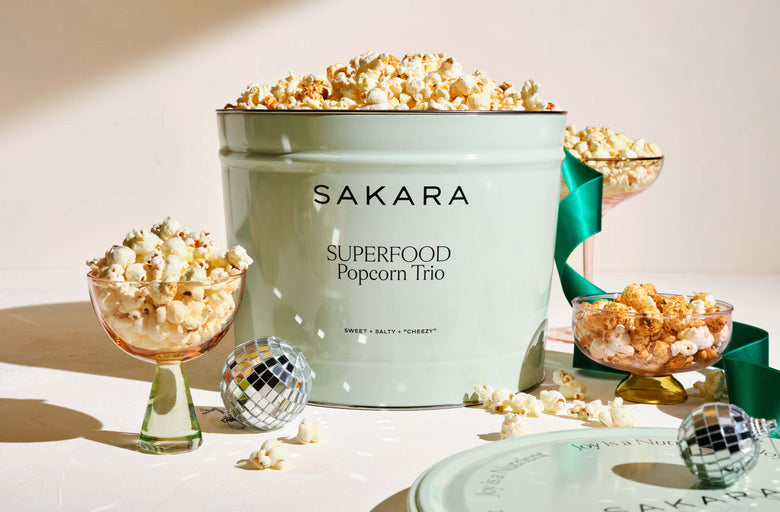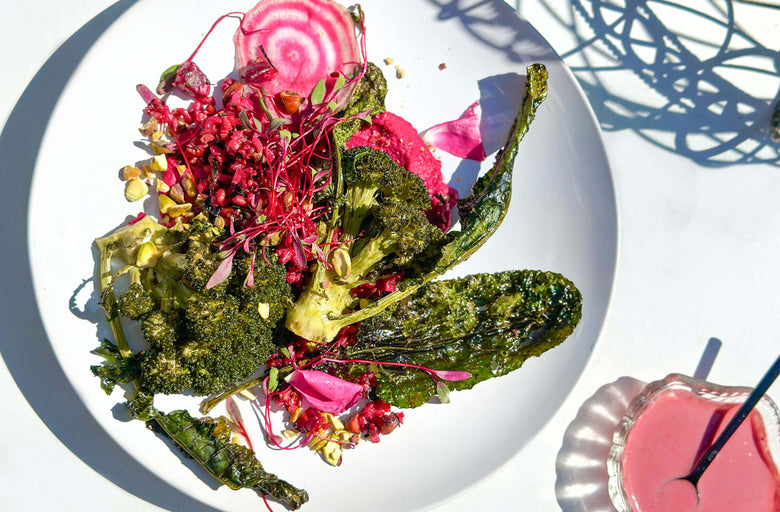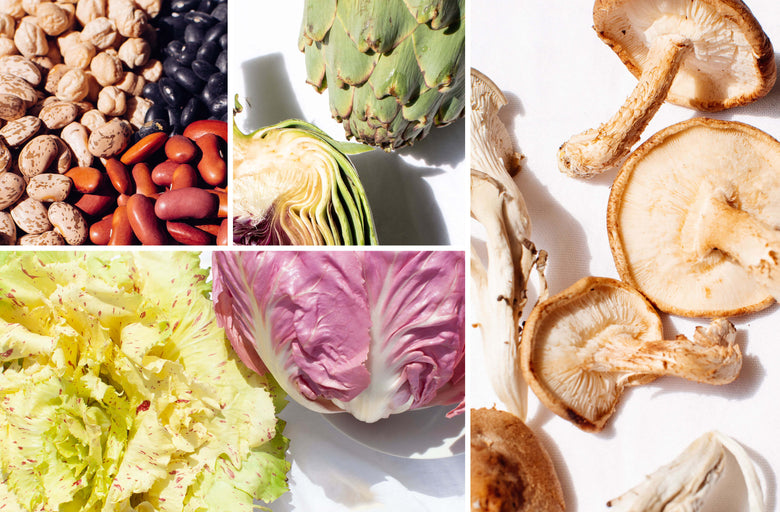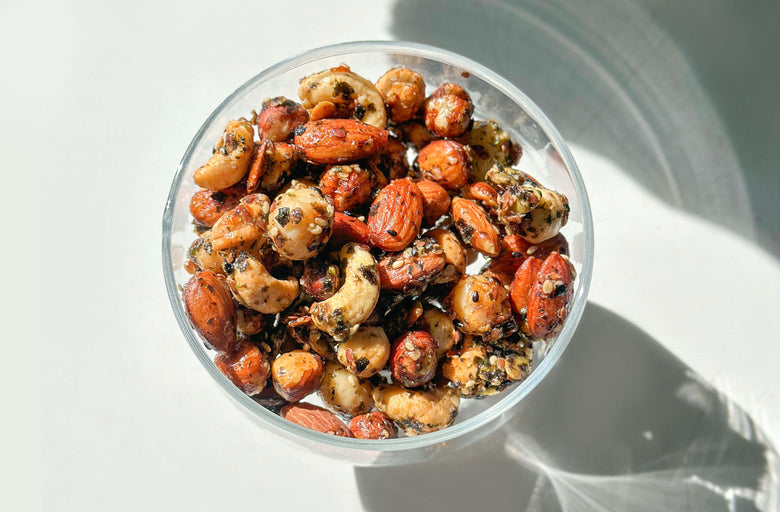To celebrate Eat Pretty, and all things in the beauty sphere, we're getting down and dirty with some of mama earth's very best, most body-healing muds and clays.
But with so much info out there, the waters often get muddied (pun intended). So we dug in deep — we're talking hundreds of feet below the earth’s surface — to bring you the dirt on this earthy stuff.
We've waded through all the muck (the puns just keep on coming!) to clear up all the confusion, and your skin! From the different types, to uses and benefits of our fave all-natural products and DIY beauty recipes, there is no shortage of skin-saving magic when it comes to these guys (with some help from dirt-loving, clean beauty experts over at Herbivore Botanicals).
Because sometimes, you have to get dirty to get (your beautiful face and body) oh so clean...
Mud vs. Clay ~
Mud is a broad term, referring to a mixture of water and some combination of soil, made up of small rock particles of various sizes, plus organic materials. Mud comes in many forms and types, and is classified by the size of the rock particles present — clay (less than .002 mm), silt (.002 mm to .05 mm) and sand (.05 mm to 2 mm).
The Nitty Gritty ~
There’s a ton of different terminology here. So, without getting too scientific, let’s break it down simply:
As you now know (or maybe you did before, in which case we’re totally impressed), clay is a specific type of mud — a naturally occurring mixture of very fine-grained soil, clay minerals and organic matter. Clay can be found in nearly every part of the world and has a wide array of diverse formations, colors and properties.
Willie Freitas over at Herbivore Botanicals says that what gives clay so many superpowers is "the multitude of active minerals that enrich this special mud.” Any given clay is usually a mixture of clay minerals (definition: the layer phyllosilicates that form near the earth’s surface impart plasticity to clay and harden upon drying or firing); with one or two minerals being predominant. From a mineralogy standpoint, clay minerals are divided into three main groups: kaolinite, illite and smectite.
Clay’s absorptive and adsorptive powers are used to remedy a variety of skin concerns. The names are more confusing than the actual scientific principles (we swear).
In clay science, absorption results where a liquid penetrates internal layers or pore spaces within the clay material. Think of it like a sponge soaking up oil and impurities.
Technically speaking, adsorption is the process of attraction, binding and accumulation of molecules to a solid surface. Think of it like a like a magnet: negatively charged clay attracts, bonds and draws out positively charged impurities.
Uses + Benefits ~
Coveted for their medicinal and cosmetic benefits since earliest recorded history, muds and clays offer a multitude of benefits, and are among the safest, most powerful healing and detoxifying ingredients.
Clay is most celebrated for its impressive detoxifying capabilities. It also absorbs excess oil and clarifies blemishes — wonderful for oily, acne-prone and problem complexions. Other types of clay gently exfoliate, while helping skin retain moisture — ideal for more sensitive, dry and aging skin. And some clays even boost circulation and skin cell regeneration — beneficial for all complexions.
With their bevy of benefits, it’s no wonder beauty dirts are an absolute essential in skin care, widely used in scrubs, cleansers, soaks and soaps all over the world.
Different Types ~
“While most clays and muds do have similar properties, varying types can have unique strengths and individual skin care benefits. These differences are due mostly to the different mineral content in each clay compound," Willie says. We've laid out the basics of each below....
Bentonite Clay:
One of the most popular, abundant and powerful healing clays, bentonite is composed of naturally occurring weathered and aged volcanic ash sediments. This highly absorbent swelling clay has a high percentage of montmorillonite (at least 30%), which gives it its extraordinary powers. Bentonite draws out oil and impurities, unclogs and shrinks pores, and heals acne while tightening and toning skin. When mixed with liquid (like clean water or apple cider vinegar), bentonite swells open like a porous sponge, drawing out toxins, oil, excess sebum, bacteria and fungus through electrical attraction. Its impurity-absorbing abilities make it ideal for oily, congested and acne-prone skin types, as well as those struggling with psoriasis and eczema. Bentonite is commonly used in over-the-counter acne treatments, bath soaks, foot, body and face masks.
For a DIY: Mix 1 tsp of Aztec Secret Indian Healing Clay (100% natural calcium bentonite clay) + 1 tsp of raw apple cider vinegar. Apply to face, let sit for 30 minutes and then rinse with lukewarm water. Finish with a splash of cool water to close pores.
Fuller’s Earth Clay (Multani Mitti Clay):
If your skin is an oil slick and nothing seems to help, we have some good news! Fuller’s earth clay literally soaks up oil (also having oily skin might help prevent wrinkles later in life, but that’s a topic for another day). We’re serious! This sedimentary clay boasts incredible drawing, pore clearing abilities and drying properties. In fact, it’s SO powerful it’s used used in the automotive industry to soak up spilled oil. In addition to sopping up sludge (on your face and elsewhere), it has mild bleaching properties and is widely used as a skin-lightening agent, and is great for reducing the appearance of dark spots and acne scars.
Cambrian Blue Clay:
Found in Siberian lakes, cambrian blue clay is known for its clarifying, detoxifying and skin balancing properties. “The cambrian blue clay we [at Herbivore Botanicals] use is one of the oldest clays found in nature, making it especially rich in a wide array of minerals. Both the age and mineral content give this clay strong detoxifying properties and make it uniquely absorbent and ideal for oily skin.” This swelling clay penetrates deeply into pores, drawing out impurities, and even puffiness caused by carrying excess water. Cambrian blue clay lends its purifying properties to spot treatments, face masks, bar soaps and detox bath salts.
French Green Clay:
One of the most majestic, effective and commonly used mineral skin clays in the world, French green clay comes from naturally occurring deposits in France, and presents a soft texture and beautiful green color due to iron oxide and decomposed plant matter. There are two types of French green clay: montmorillonite and illite. While both have similar therapeutic properties, they also have specific differences.
French Green Montmorillonite Clay:
Unearthed in the South of France, French green montmorillonite has a much higher mineral content than illite — it’s rich in magnesium, iron, manganese, calcium, silica and and nutrients. Its swelling, absorbing and remineralizing abilities make it ideal for body wraps, compresses, baths and face masks. Particularly, for oily complexions, a weekly mask can regulate skin’s sebum production.
French Green Illite Clay:
Excavated from certain regions in the North of France and the Atlantic basin, French green illite is often referred to as sea clay or marine clay, due to the quarries being found in the ancient marine beds. This non-swelling clay has a lighter hue than montmorillonite and is superbly detoxifying. Its high sorptive capacity draws out toxins, and its negative ionic charge helps to attract, bind and eliminate positively charged impurities. In addition to decongesting problem complexions, its toning action stimulates the skin by bringing fresh blood to the surface, tightening pores and exfoliating dead skin cells. It’s commonly used in compresses, poultices, detox baths, face masks and body wraps.
French Red Illite Clay:
Like other illite clays, this guy has a strong negative ionic charge and a wealth of iron oxide, which gives it a rich red hue and high mineral content. A powerful cleanser, detoxifier and exfoliator, French red illite clay is commonly used in the beauty and cosmetics industry for its unique ability to purify congested skin while simultaneously reviving dull, aging skin. When activated by contact with water, the ionic exchange draws out impurities and stimulates blood circulation by depositing essential nutrients. This process increases oxygen flow to your cells, boosts hydration, aids in healing, and reduces the appearance of wrinkles and broken capillaries. Due to its enhanced ability to stimulate the body’s circulatory system, French red illite clay is a staple in rejuvenating baths, body wraps, and face and body scrubs.
French Pink Clay (Rose Clay):
A combination of red illite and white kaolin clays, “French pink has has as high concentration of iron oxide and silica, which work to increase skin cell regeneration, improving elasticity and circulation.” This fine rose colored powder is great for gently exfoliating and softening skin. Its mild properties make it perfect for normal, sensitive and mature skin types, and is commonly used in gentle scrubs and bar soaps.
Kaolin Clay:
Derived from weathered rocks in hot, humid climates, kaolin is one of the most versatile and widely used clays. It gently exfoliates, cleanses and stimulates skin. And because it blends so well with water, it’s used in everything from masks to cleansers.
White Kaolin Clay (White Cosmetic Clay):
The mildest of all clays, white kaolin is less absorbent than other varieties (meaning it doesn’t draw oils from the skin) and is extremely moisturizing, making it perfect for those with sensitive, aging and especially dry skin. And as the name would suggest, it’s a popular ingredient in cosmetics, found in the majority of all powdered and dry cosmetics.
Yellow Kaolin Clay:
This mild cosmetic clay is suitable for most skin types — particularly normal and sensitive. It helps stimulate circulation and promote cell regeneration, while cleansing to remove impurities (without stripping natural oils) and gently exfoliating skin. No surprise that it’s a star ingredient in brightening masks.
Pink Kaolin Clay (Rose Kaolin Clay):
A mix of red and white clays, pink kaolin is mildly detoxifying and exfoliating; it increases circulation, and reduces irritation and inflammation — making it ideal for normal and combination complexions.
Red Kaolin Clay:
The most purifying of the cosmetics clays, red kaolin is best for oily skin (and is not recommended for sensitive or dry complexions!). It purifies, cleanses and removes toxins, dirt, excess oil and surface debris, making it ideal for weekly detoxifying face and body masks.
Rhassoul Clay (Moroccan Lava Clay or Moroccan Red Clay):
Sourced from the Atlas Mountains in Morocco, rhassoul has been prized for its therapeutic benefits for more than 1400 years. This mineral-rich ancient clay (with high percentages of silica and magnesium) has a greater ability to absorb excess oil, draw out toxins and clear clogged pores, and is even gentle enough for individuals with highly sensitive skin. It improves elasticity, exfoliates dead skin and stimulates circulation. This rare and luxurious clay easily mixes with water and other moisturizing ingredients, and is an effective cleanser, soap, facial mask and body wrap. No wonder rhassoul is a staple at many of the best spas around the world!
Umbrian Clay:
As its name would suggest, this naturally occurring clay is indigenous to Umbria, Italy. Thanks to its high mineral content, this purifying powerhouse acts like a sponge for oil, neutralizing acidity, refining pores, absorbing toxins, and reducing breakouts to soothes all irritation. Its super absorbent and anti-inflammatory properties make it a featured ingredient in many purifying masks and spot treatments for blemish-prone complexions.
Dead Sea Mud:
Revered for its restorative and therapeutic benefits, Dead Sea Mud has high concentrations of salts and minerals (magnesium, sodium, potassium and calcium). Ideal for both face and body, it cleanses, exfoliates, improves texture, clarity and tone, balances pH and improves overall skin health. It also offers a host of healing benefits: easing aches and pains, soothing sore muscles, helping to relieve stress and providing a sense of calm. This spa quality, therapeutic mud is popular in body wraps, soaps and cleansers. What doesn’t this miracle mud do?!
European Moor Mud (Therapeutic Peat Moss or Balneo-Peat):
Traditionally found in the Czech Republic and Hungary, European moor mud is an organic product of natural decomposition of herbs, flowers and grasses. This ancient mud is rich in thermal minerals, plant enzymes, trace elements, amino acids and vitamins. And unlike other muds, it contains virtually no clay. European moor mud is popular in skin care products and luxury spa services, due to its ability to cleanse, detoxify, improve circulation, soothe, heal and rejuvenate skin. And the high humic acid content enhances this magical mud’s natural anti-inflammatory abilities, helps to reduce aches and pain and even smoothes the appearance of cellulite. This fine paste dissolves in the water (don’t worry it won’t clog your bathroom drain), making it ideal for immersion bath therapy. It’s also commonly used in body wraps, masks and massage treatments.






